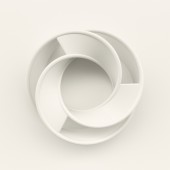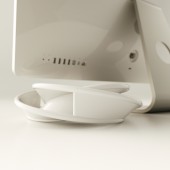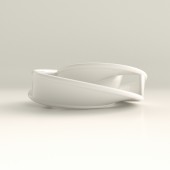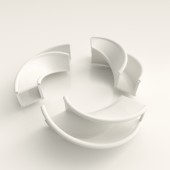|
|
|

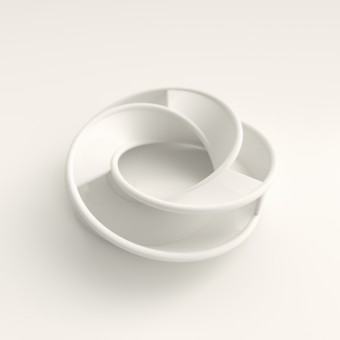
|
|
| DESIGN DETAILS |
DESIGN NAME:
Epi-Happy
PRIMARY FUNCTION:
Tableware
INSPIRATION:
This design is heavily influenced by the works of M.C. Escher on one-sided surfaces, firstly discovered by A.F. Mobius and inspired from two-dimensional repeatable decorative patterns and the hidden mathematical theorem underneath them. Decoration and ornament pattern has been evident in civilizations since the beginning of recorded history mostly as surface modulations. Despite the fact of the apparent lack of ornaments of 20th century modern architecture and applied arts, Epi-Happy is here to remind that these kind of patterns are a tremendous source of inspiration: Geometrically speaking Epi-Happy (hence the name) is the trace of the trajectory of an epicycloid in three-dimensional space.
UNIQUE PROPERTIES / PROJECT DESCRIPTION:
Epi-Happy is a small centerpiece for a dinner table or an office desk. The inspirational background -a translation in three dimensional space of ornamental motifs- make it a classic yet a contemporary stylish object with smooth lines and a funny playful mood. A triple repetition of a basic unit creates a continuous storage area that can store or display several small objects, varying from small fruits and ornaments to keys and usb devices. Epi-Happy is a friendly space occupant. The empty space in the center of the centerpiece has the advantage of being used in addition to an already-existing centerpiece, be it a vase of flowers, a candle holder or anything that fits in. Of course you can just throw a ball in it and try to roll it round and round. This way Epi-Happy can act as an anti-stress device for adults or became a game to practice dexterity for minors.
OPERATION / FLOW / INTERACTION:
Three Units assembled in place with magnetic force, or pre-assembled during manufacturing process, form a continuous storage space for domestic or office usage. The Basic Unit can have alternative side endings, so dividing the continuous space in half or thirds is also possible.
PROJECT DURATION AND LOCATION:
The project started in October 2013 in Thessaloniki and finished in January 2014.
|
PRODUCTION / REALIZATION TECHNOLOGY:
The Basic Unit will be slip-cast (produced from liquid clay in plaster mold) and will be produced in White Ceramic material. The cast piece will be removed from the mold, then trimmed neatly and allowed to dry. This produces a greenware piece which is then dried and glazed before firing the units into a kiln. If possible, during the drying process, the units will be connected to form the final shape, else, the units will be connected to each other with Alnico V or Ceramic cylindrical shaped magnets. The pole pieces will be recessed in the edges of each Unit.
SPECIFICATIONS / TECHNICAL PROPERTIES:
Width mm x Depth mm x Height mm = 180 x 180 x 56mm
TAGS:
tableware, decorative, office desk, centerpiece, centrepiece
RESEARCH ABSTRACT:
This design is a study on the slip-casting ceramic fabrication method used for manufacturing complex continuous three-dimensional geometrical defined forms that can be materialized easily once they are made of a repeatable basic unit.
CHALLENGE:
The challenge was to create a complex continuous surface using a single element with a simple form that’s easy to reproduce.
ADDED DATE:
2014-07-09 11:47:41
TEAM MEMBERS (1) :
IMAGE CREDITS:
Image #1: Architect George Drakakis, Epi-Happy, 2014.
Image #2: Architect George Drakakis, Epi-Happy, 2014.
Image #3: Architect George Drakakis, Epi-Happy, 2014.
Image #4: Architect George Drakakis, Epi-Happy, 2014.
Image #5: Architect George Drakakis, Epi-Happy, 2014.
|
| Visit the following page to learn more: http://iconpoetry.com/wp/centerpiece/ |
|
| CLIENT/STUDIO/BRAND DETAILS |
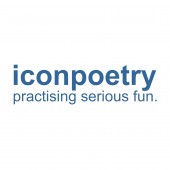 |
NAME:
ICONPOETRY
PROFILE:
A design studio that keeps practising serious fun. This is the place to design projects at the border of art and design, at the edge of reality and fantasy, constantly reminding that "Poiesis" and Poetry is one and the same, following one simple rule: Form Follows Satis-Function. oh yeah.
This entry is made possible with the help of John F., Arik T. and Christian A.
|
|
|
| COMMENTS |
| Giulia Esposito |
Comment #1662 on December 24, 2022, 8:41 pm |
|
I am in awe of the creativity of this work! Epi-Happy is an innovative and beautiful piece of tableware that stands out from the usual design. Its fun and quirky design makes it a pleasure to use while dining. The attention to detail in the craftsmanship is impressive and its obvious that a lot of thought and effort went into making such a unique piece. It is a design that will be remembered and admired for years to come. Congratulations to George Drakakis for winning the A' Design Award for this remarkable piece!
|
| Paul Williams |
Comment #21679 on January 3, 2023, 6:48 am |
|
Epi-Happy is an exemplary work of design that is truly remarkable. Its smooth lines and playful mood creates a classic yet contemporary centerpiece that is both aesthetically pleasing and practical. The empty space in the center of the piece can store or display small objects, making it a useful accessory for any dinner table or office desk. The inspiration behind the design is a unique translation of ornamental motifs into three-dimensional space, giving the piece a timeless quality that is both beautiful and functional. The slip-casting method used in the production of the piece allows for a complex continuous surface that is easy to reproduce. All in all, Epi-Happy is an exemplary design that is a true testament to the power of good design.
|
| Paul Phillips |
Comment #23272 on January 3, 2023, 7:19 am |
|
What an incredible work of design! Epi-Happy is a perfect combination of modern and classic aesthetics, with its smooth lines and ornamental motifs. The cleverly designed centerpiece is practical and visually appealing, providing a storage area for small items and creating a beautiful accent in any space. I love the idea that it can act as an anti-stress device or a game to practice dexterity, making it a great choice to decorate any dinner table or office desk. It's inspiring to see such creativity and innovation in design, and I'm thrilled that it has been recognized with an A' Design Award. Congratulations to George Drakakis for this amazing accomplishment!
|
| Adam Harris |
Comment #23450 on January 3, 2023, 7:22 am |
|
I am beyond impressed with the amazing design of Epi-Happy. The clever combination of classic and contemporary styles, as well as the playful mood of the centerpiece, makes it truly unique. The clever storage space that is created by the triple repetition of the basic unit, is not only practical but also aesthetically pleasing. The inspiration behind the design is truly inspiring, as it pays homage to the works of M.C. Escher and hidden mathematical theorems. The slip-casting ceramic fabrication method used for manufacturing it adds an extra element of sophistication to the design. It is truly remarkable how the designers managed to create a complex continuous surface using a single element with a simple form. This work is a wonderful example of good design and an admirable achievement for the designer.
|
| Elisabeth Clark |
Comment #25106 on January 3, 2023, 7:54 am |
|
I am absolutely mesmerized by George Drakakis's design. Epi-Happy is a stunning work that has successfully blended the beauty of ornamental motifs with contemporary stylish lines and a playful mood. This multifunctional centerpiece is a great way to add a touch of class and personalization to any dinner table or office desk. The empty space in the center can be used to store or display small items, making it a great addition to any existing centerpiece. The idea behind this design is inspired and innovative, and I'm impressed by the research that went into it to make it come to life using the slip-casting ceramic fabrication method. George Drakakis has truly created a unique and special piece of design.
|
| Chloe Turner |
Comment #25223 on January 3, 2023, 7:56 am |
|
The creative talent of George Drakakis is truly remarkable. Their work, "Epi-Happy", is a stunning example of modern design that pays homage to the great works of M.C. Escher and A.F. Mobius. The intricate geometrical patterns featured in "Epi-Happy" are a testament to the skilled craftsmanship and attention to detail used in its creation. The subtle yet bold decorations of "Epi-Happy" add a unique touch of elegance to any room. The A' Design Award is a well-deserved recognition of the hard work and dedication put into this amazing piece of design. It is no wonder why George Drakakis has been acknowledged as a winner in the Bakeware, Tableware, Drinkware and Cookware Design category of the A' Design Award.
|
| Mark Allen |
Comment #26189 on January 3, 2023, 8:15 am |
|
This award-winning work is a stunning example of design ingenuity. The unique properties of the design create a playful and stylish centerpiece that can be used to store and display small objects. The inspiration behind the work is a tribute to the mathematical theorem underneath decorative patterns and the use of slip-casting ceramic fabrication method for manufacturing the complex continuous three-dimensional geometrical defined forms. The challenge of creating a complex continuous surface with a single element was successfully achieved, making this design an impressive feat.
|
| Elena Petrenko |
Comment #28357 on January 3, 2023, 8:57 am |
|
Epi-Happy is a unique and playful centerpiece that is both classic and contemporary, perfect for any dinner table or office desk.
|
|
|
Did you like George Drakakis' Kitchenware Design?
You will most likely enjoy other award winning kitchenware design as well.
Click here to view more Award Winning Kitchenware Design.
Did you like Epi-Happy Tableware? Help us create a global awareness for good kitchenware design worldwide. Show your support for George Drakakis, the creator of great kitchenware design by gifting them a nomination ticket so that we could promote more of their great kitchenware design works.
|
|

|
|
|
|




